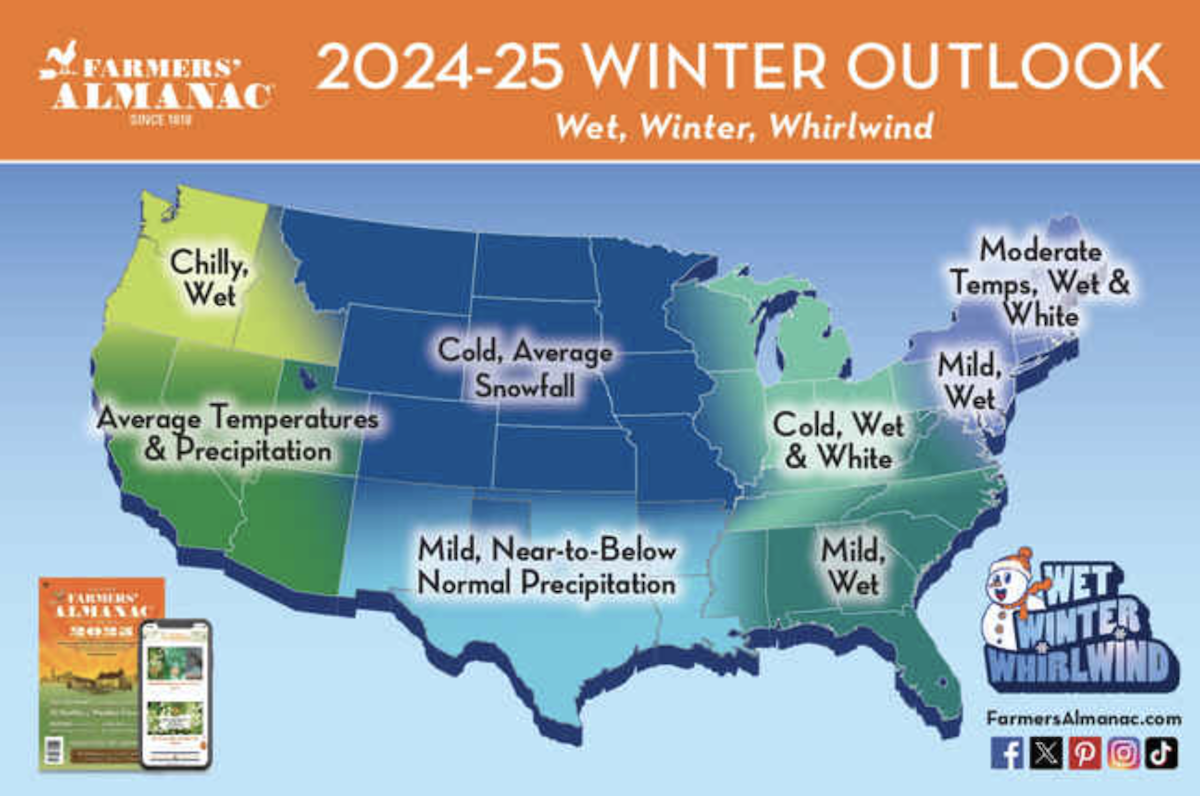This Winter Will Be Full of “Rapid-Fire Storms,” Farmers’ Almanac Predicts

With any luck, the worst of the summer heat is behind us. There’s a brisk chill in the air, promising the start of sweater weather. Autumn is arguably one of the better parts of the year, where the days are still long with mild temperatures, and Mother Nature is, for the most part, on its best behavior. And while many of us are counting down the days until we can slip into a cable-knit cardigan and rewatch Gilmore Girls, some weather experts already have their sights set on winter. As a matter of fact, the Farmers’ Almanac is issuing an early winter advisory for the 2024-2025 season.
RELATED: Forecasters Predict 23 Named Storms This Season, Including 11 Hurricanes.
This winter is forecasted to be a “Wet Winter Whirlwind,” according to the Farmers’ Almanac. After enduring back-to-back winters with very little snow and warmer-than-average temperatures, the upcoming winter outlook predicts “a season of rapid-fire storms that will bring both rain and snow, with little downtime in between.”
Winter officially kicks off on Dec. 21, 2024. However, the Farmers’ Almanac says that the brunt of the season will hit after the new year, going into late January/early February. A very active storm track is expected to deliver “frequent bouts of heavy precipitation, as well as strong and gust winds” from Jan. 20, 2025, to Jan. 27, 2025.
It might be best to hunker down inside with a cup of hot cocoa during this time, warns the Farmers’ Almanac, which is officially “red flagging” the final week of January. However, the frigid Arctic air won’t be felt throughout all 50 states due to La Niña. The climate pattern, which occurs every three to five years, will influence which regions get more rain than snow.
“It definitely looks more wet than white in many areas,” Farmers’ Almanac editor Sandi Duncan told USA Today. “Obviously, depending on where you live, there might be more white than wet, but we’re focusing in on the wet winter ahead.”

Looking at the 2024-2025 winter forecast at a glance, the Northeast is expected to have “chilly” temperatures and lots of rain. Meanwhile, California, Arizona, Utah, and Nevada are forecasted to have “average temperatures” and some precipitation. As per usual, the Northern Plains and Midwest will have the harshest winter with average amounts of snowfall.
Those in Texas and other neighboring states are predicted to have “mild, near-to-below normal precipitation.” However, a possible snowstorm could bring up to six inches of snow in Texas during the first half of February, says the Farmers’ Almanac.
Snowbirds flocking to the Southeast region can expect typical mild temperatures and rain. Going east, especially towards the Great Lakes and Ohio Valley, weather is forecasted to be “cold, wet, and white,” meaning both rain and snow are expected.
For the third winter in a row, New England will have a stormy and wet winter. The Farmers’ Almanac foresees inland terrain (like the mountains) getting heavy snowfall, while cities hugging the coast, like New York City, will have “above-normal amounts of winter precipitation and near-to-above normal temperatures.” In addition to rain, sleet may also occur along the coast due to La Niña.
The Northeast region will experience a similar winter but with more snow than rain.
“The coldest temperatures look like they’re going to be over the North Central States into the Great Lakes area,” Duncan summed up to USA Today. And because frigid temps are predicted to “hang on” longer than normal in some regions, “it’s going to feel like a longer winter, even if it’s a little warmer in certain areas that usually get snowier conditions,” she said.